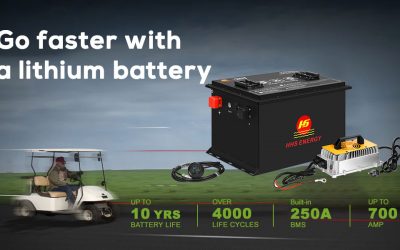How Many Lithium Batteries for a Golf Cart?

Your Complete Guide to Choosing the Right Battery Setup
Introduction
Golf carts have come a long way from being simple vehicles used only on golf courses. Today, they’re used in retirement communities, resorts, farms, warehouses, and even neighborhoods. As their use expands, so does the need for efficient, long-lasting, and powerful batteries.
For decades, lead-acid batteries were the default choice. But in recent years, lithium batteries—especially LiFePO₄ (Lithium Iron Phosphate)—have become the gold standard for powering golf carts.
A common question from cart owners is:
“How many lithium batteries do I need for my golf cart?”
The answer depends on several factors:
-
Voltage requirement of your cart (36V, 48V, or 72V)
-
Battery configuration (single pack vs multiple smaller packs)
-
Desired runtime and range
-
Budget and upgrade goals
This guide will break it all down for you.
Understanding Golf Cart Voltage Requirements
Most golf carts are designed to run on a specific voltage system:
-
36V carts → Usually older models (common in EZGO, Club Car)
-
48V carts → The most popular today, balancing power & efficiency
-
72V carts → High-performance models for speed & hill climbing
Your battery setup must match the voltage requirement of your golf cart’s motor and controller. Installing the wrong voltage can damage your system.
How It Works
Each lithium battery has a nominal voltage (e.g., 12V, 24V, 48V). To meet your cart’s requirement, you either:
-
Use a single large lithium pack (e.g., one 48V pack for a 48V cart).
-
Connect smaller batteries in series (e.g., four 12V lithium batteries in series = 48V).
Option 1: Single Large Lithium Battery Pack
The simplest solution is to buy one lithium battery pack designed specifically for golf carts.
For example:
-
A 48V 105Ah LiFePO₄ battery can fully power most 48V golf carts.
-
A 36V 100Ah lithium battery works for a 36V cart.
Advantages:
✅ Easy installation (just one battery)
✅ Fewer connections = less maintenance
✅ Compact design saves space
✅ Often comes with built-in Battery Management System (BMS)
Disadvantages:
❌ Higher upfront cost for a single pack
❌ If one pack fails, the whole cart is down
Illustration: A single 48V lithium battery mounted in a golf cart battery compartment.
Option 2: Multiple Lithium Batteries in Series
Some owners prefer connecting multiple smaller lithium batteries in series to reach the needed voltage.
For example, for a 48V cart:
-
Four 12V 100Ah lithium batteries (4 × 12V = 48V)
-
Two 24V 100Ah lithium batteries (2 × 24V = 48V)
For a 36V cart:
-
Three 12V lithium batteries (3 × 12V = 36V)
Advantages:
✅ Flexible & modular setup
✅ Easier to replace a single battery if needed
✅ Sometimes cheaper than a single large pack
Disadvantages:
❌ More wiring & installation complexity
❌ Requires a proper BMS for balance
❌ Takes up more space
Illustration: Four 12V lithium batteries connected in series to power a 48V golf cart.
How Many Batteries Do You Actually Need?
Here’s a quick breakdown based on typical golf cart setups:
| Golf Cart Voltage | Battery Option 1 (Single Pack) | Battery Option 2 (Series Connection) |
|---|---|---|
| 36V Cart | 1 × 36V 100Ah pack | 3 × 12V lithium batteries |
| 48V Cart | 1 × 48V 105Ah pack | 4 × 12V lithium OR 2 × 24V lithium |
| 72V Cart | 1 × 72V lithium pack | 6 × 12V lithium OR 3 × 24V lithium |
How Battery Capacity Affects Runtime
Beyond voltage, amp-hours (Ah) determine how long your cart runs on a charge.
-
100Ah pack → Average 30-40 miles per charge (for 48V cart)
-
150Ah pack → Extended 50-60 miles per charge
-
200Ah pack → Long-range performance carts
If you use your cart only for golf, a 100Ah lithium battery is usually enough. For long rides, heavy loads, or steep hills, consider higher capacity.
Lithium vs Lead-Acid: Why Fewer Lithium Batteries Are Needed
Traditional lead-acid golf carts often use 6 or 8 batteries (6V or 8V each). Lithium technology allows you to replace all of those with just 1–4 lithium batteries, depending on your setup.
Benefits of switching to lithium:
-
50–70% lighter → Better speed & efficiency
-
5× longer lifespan (8–10 years vs 2–3 years for lead-acid)
-
Faster charging (2–4 hours vs 8–10 hours)
-
No maintenance (no watering, no corrosion)
Cost Considerations
How many lithium batteries you need also depends on your budget.
-
Single 48V 105Ah lithium pack → $2,800–$3,500
-
Four 12V 100Ah lithium batteries → $2,400–$3,000 total
-
High-capacity 48V 200Ah pack → $4,500+
Yes, the upfront cost is higher than lead-acid, but long-term savings in replacement, maintenance, and electricity make lithium the more economical choice.
Installation Tips
-
Always check your golf cart’s manual for voltage & wiring requirements.
-
Use heavy-duty cables to prevent overheating.
-
Ensure your lithium pack includes a BMS (protects from overcharging, overheating, and short circuits).
-
Consider upgrading to a lithium-compatible charger for maximum efficiency.
Frequently Asked Questions (FAQ)
1. Can I mix lead-acid and lithium batteries?
❌ No, mixing battery types can damage your cart.
2. Do I need to reprogram my golf cart after switching to lithium?
✅ Sometimes. Some carts require a controller adjustment for optimal performance.
3. How many years will lithium golf cart batteries last?
👉 8–10 years with proper use (compared to 3–5 years for lead-acid).
4. Can I add more batteries later if I want longer range?
✅ Yes, if your setup is modular (series connection).
Conclusion
The number of lithium batteries you need depends on your cart voltage and whether you prefer a single pack or multiple smaller batteries in series.
-
36V carts → 1 × 36V lithium pack or 3 × 12V lithium batteries
-
48V carts → 1 × 48V lithium pack or 4 × 12V lithium batteries
-
72V carts → 1 × 72V lithium pack or 6 × 12V lithium batteries
If you want simplicity and reliability, go with a single lithium pack.
If you want flexibility and lower upfront cost, use multiple smaller batteries in series.
Either way, switching to lithium will give your golf cart more power, longer range, and a longer-lasting battery system.




